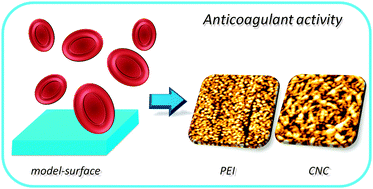Design of anticoagulant surfaces based on cellulose nanocrystals†
Abstract
The anticoagulant activity of surfaces decorated with cellulose nanocrystals (CNCs) prepared via sulfuric acid hydrolysis, is explored. Such surfaces bear a high amount of negatively charged sulfate groups, which mimic the naturally occurring anticoagulant heparin in terms of charge density. It is demonstrated that CNC decorated surfaces significantly enhance the coagulation times of blood plasma and whole blood as proven by QCM-D and simple clotting tests.


 Please wait while we load your content...
Please wait while we load your content...